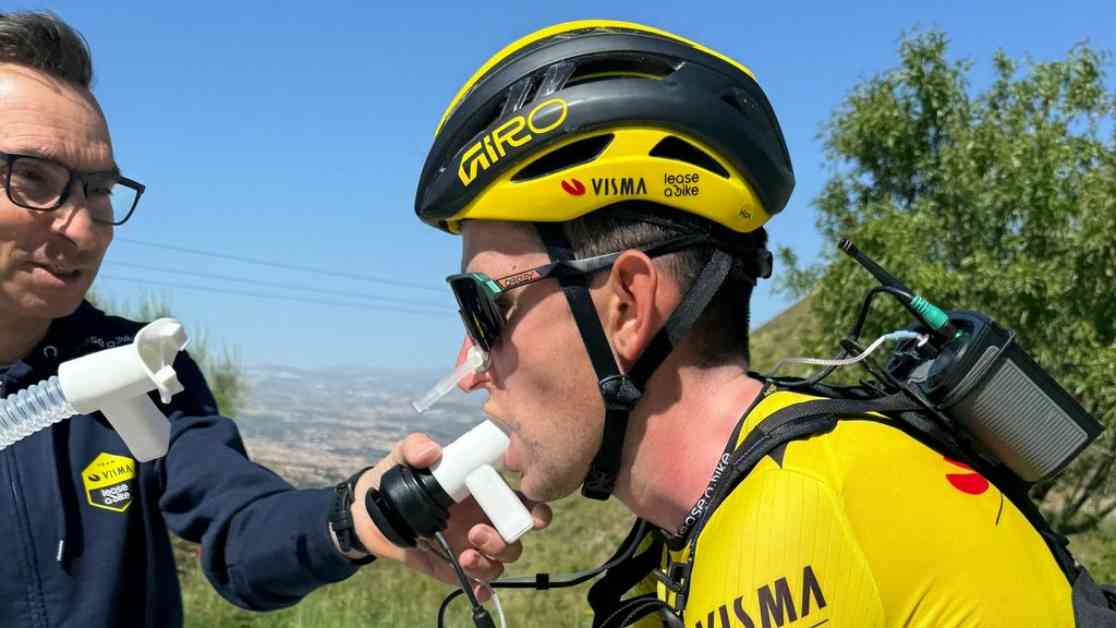One of the many methods around ’training the gut’. Asker Jeukendrup in May on a high-altitude training camp with Tiesj Benoot
The past two years, Jonas Vingegaard won the Tour de France. Both times he defeated Tadej Pogacar in an exciting duel, and both times the Slovenian had this thought afterwards: did I do something wrong?
In 2022, there was a bonk on Col de Granon. And a year later, he, as he concluded himself, had eaten too much in the seventeenth stage on the way to Col de la Loze.
How this edition will go, starting from Saturday, June 29, is still a question. But the experiences of the recent Tours lead to the cautious conclusion that UAE-Emirates were not – or are not – handling nutrition and exercise in the same way as the Dutch Visma-Lease a Bike team.
What is the best method to get riders as fit as possible?
So detailed, so structured
“I don’t think Pogacar’s team is anywhere near our system, to be honest,” says Asker Jeukendrup, the professor who has been in charge of nutrition at the yellow-black team since 2017. The same man who sets the guidelines for nutrition at NOC*NSF.
Jeukendrup doesn’t want to criticize other teams, that’s not his intention, but he says it because the team of technical director Merijn Zeeman goes quite far. For example, in 2018, there was one chef employed. But that wasn’t enough. A nutrition app was introduced, customized advice for each rider resulting in fifteen chefs being employed this year. Chefs who are all nutrition experts. Leaving nothing to chance.
“It leads to an advantage that is almost impossible for other teams to catch up with,” Jeukendrup knows.
“Many teams are still looking for that last new miracle. Or they buy a large food truck and think they are done with the investment in nutrition. While it’s often very basic things. What do the riders get inside? That can go right or wrong with every meal.”
The maximum amount of carbohydrates you can consume is around 120 or 130 grams per hour.
What is on the plate during meals is one aspect of training the gut. A more interesting aspect is what is consumed during races. For a long time, it was thought that riders could consume a maximum of 60 grams of carbohydrates per hour without experiencing intestinal problems.
A study by Jeukendrup in 2004 found that this was not correct. “We discovered that there is another transporter in your intestines that allows you to burn energy. Not just one. We have done many studies on various combinations of carbohydrates, but we ultimately arrived at the combination of fruit sugar and grape sugar. Namely fructose and glucose. Both use a different transporter in the intestines.”
‘Effects are not small’
Jeukendrup: “In principle, you can therefore get almost a hundred percent more carbohydrates into the body. That won’t get you gold medals just by burning carbohydrates alone, but we have also found that it does significantly improve performance. Up to seventeen percent. Those effects are not small.”
Where Jeukendrup talks about an average intake of 90 grams of carbohydrates per hour during a race, pushing it towards 120 or 150, a nutritionist from Pogacar recently confirmed those numbers. “The maximum is around 120 or 130 grams per hour,” Gorka Prieto said in April on Cyclingnews.
Then the next question arises: when do you apply what? Jeukendrup also raises this question in relation to ketones, a legal substance that has been used within the peloton for years. It can help your body recover faster.
Ketones
Jeukendrup: “They contribute somewhere between 0 and 2 percent. To be very honest, based on scientific research, it is very difficult to make a statement about that. Two percent is extremely high and 0 percent is nothing. And it could also have negative effects in certain situations.”
Aside from Visma, it is known that at least Alpecin-Deceuninck and Soudal-QuickStep use the substance.
“You have to be careful sometimes. Everyone hears about it and everyone starts taking it, but you also have to think about what exactly you are doing. There are also studies showing negative effects. On long-term performance, due to the gastrointestinal problems it causes, but also on short, high-intensity efforts.”
Stomach problems
In the medical bulletins of major tours, reports of stomach problems are becoming more common. Jeukendrup: “I think there are more reasons for that. Stomach problems are quite common in endurance sports. This has everything to do with what exactly you take in when.”
“What are the weather conditions, how tough is it? Those are all factors that play a role. And if you also take in carbohydrates, with gels and other products, you will of course cause intestinal problems. And if you then also take ketones, which many do, then it will not make it better. And if you also take salt tablets on top of that, which many do, then you make it even worse.”

